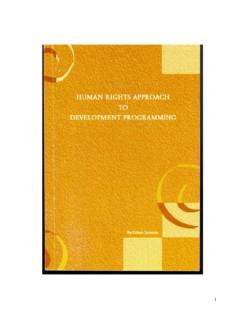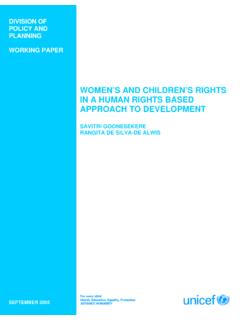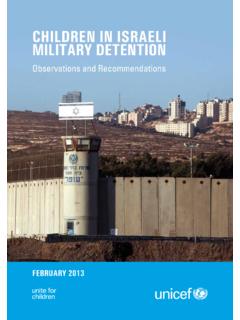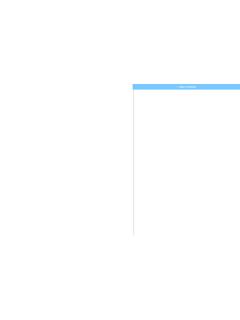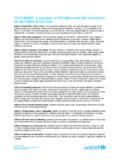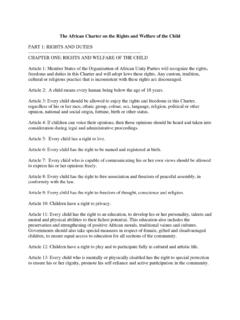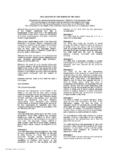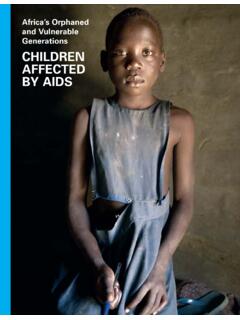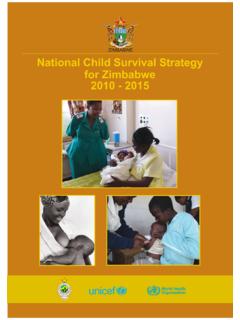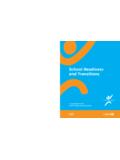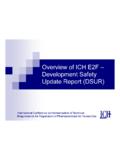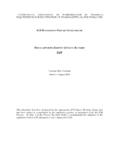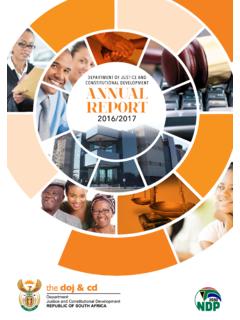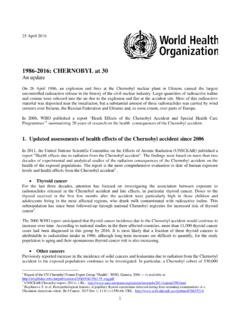Transcription of Progress on and Pd rnoges2 - Home page | UNICEF
1 Progress on D inking Water and 2012. UPDATE. UNICEF and World Health Organization 2012. All rights reserved. UNICEF and the World Health Organization welcome requests for permission to reproduce or translate their publications whether for sale or for non-commercial distribution. Applications and enquiries should be addressed to UNICEF , Division of Communication, 3 United Nations Plaza, New York 10017, USA (fax: +1 212 303 7985; e-mail: or to WHO Press through the WHO website: http://www. The designations employed and the presentation of the material in this publication do not imply the expression of any opinion whatsoever on the part of UNICEF or the World Health Organization concerning the legal status of any country, territory, city or area or of its authorities, or concerning the delimitation of its frontiers or boundaries. Dotted and dashed lines on maps represent approximate border lines for which there may not yet be full agreement. The figures included in this report have been estimated by the WHO/ UNICEF Joint Monitoring Programme for Water Supply and Sanitation ( ) to ensure compatibility, thus they are not necessarily the official statistics of the concerned country, area or territory, which may use alternative rigorous methods.)
2 UNICEF and the World Health Organization do not warrant that the information contained in this publication is complete and correct and shall not be liable for any damages incurred as a result of its use. WHO Library Cataloguing-in-Publication Data Progress on Drinking Water and Sanitation: 2012 Update 1. Water supply standards. 2. Potable water supply and distribution. 3. Sanitation 4. Millennium development Goals. 5. Programme evaluation I. WHO/ UNICEF Joint Monitoring Programme for Water Supply and Sanitation. ISBN: 978-92-806-4632-0 (NLM classification: WA 670). ISBN: 972-924-1503297. Printed in the United States of America Design: Emerson, Wajdowicz Studios / NYC / Photo Credits: Front Cover The Water Institute at the University of North Carolina (UNC)/Heather Arney, 2011, India; P. i UNICEF /Warrick Page; P. 3 UNICEF /Olivier Asselin; P. 4 UNICEF /Kate Holt; P. 8 UNICEF /Noah Friedman-Rudovsky; P. 11 UNICEF /Eric Bouvet; P. 12 UNICEF /. Veronique de Viguerie; P. 14 UNICEF /Jean-Baptiste Lopez; P.
3 15 UNICEF / Marta Ramoneda; P. 16 UNICEF /Josh Estey; P. 18 UNICEF /. Susan Markisz; P. 22 UNICEF /Marco Dormino; P. 23 UNICEF /Kate Holt; P. 25 UNICEF /Marco Dormino; P. 26 UNICEF /Olivier Asselin;. P. 27 UNICEF /Olivier Asselin; P. 28 UNICEF /Ami Vitale; P. 29 UNICEF /Roger LeMoyne; P. 31 (top): UNICEF /Olivier Asselin; (bottom): UNICEF /. Shehzad Noorani; P. 32 UNICEF /Tibebu Lemma; P. 37 UNICEF /Roger LeMoyne; Back Cover The Water Institute at UNC/Emily Zuehlke, 2011, Uganda Progress on D inking Water and 2012. UPDATE. Progress on Drinking Water and Sanitation > 2012 Update Foreword Since the adoption of the Millennium development Goals, the WHO/ UNICEF Joint Monitoring Programme for Water Supply and Sanitation has reported on Progress towards achieving Target 7c: reducing by half the proportion of people without sus- tainable access to safe drinking water and basic sanitation. This report contains the welcome announcement that, as of 2010, the target for drinking water has been met.
4 Since 1990, more than 2 billion people have gained access to improved drinking water sources. This achievement is a testament to the commitment of Government leaders, public and private sector entities, communities and individuals who saw the target not as a dream, but as a vital step towards improving health and well-being. Of course, much work remains to be done. There are still 780 million people without access to an improved drinking water source. And even though billion people have gained access to improved sanitation since 1990, the world remains off track for the sanitation target. It is essential to accelerate Progress in the remaining time before the MDG deadline, and I commend those who are participating in the Sustainable Sanitation: Five Year Drive to 2015. This report outlines the challenges that remain. Some regions, particularly sub- Saharan Africa, are lagging behind. Many rural dwellers and the poor often miss out on improvements to drinking water and sanitation.
5 And the burden of poor water supply falls most heavily on girls and women. Reducing these disparities must be a priority. The recognition by the UN General Assembly, in 2010, of water and sanitation as a human right provides additional political impetus towards the ultimate goal of providing everyone with access to these vital services. Many countries and agencies have joined hands in the Sanitation and Water for All partnership. Such collective efforts offer real promise and I urge all partners to contribute. I commend this report to all those working towards universal access to safe water and sanitation. Achieving the MDG drinking water target is a major step, but ultimately, only one step on a long journey that we have yet to finish. Let us use this success to invest our mission for sustainable, equitable development with renewed vigour so we can create the future we want. Ban Ki-moon Secretary-General, United Nations Contents 02 Looking Forward, Looking Back 03 Global Drinking Water Trends 1990-2010.
6 04 Progress Towards the MDG Target 08 Regional Trends 11 An Alternative Indicator of Progress 12 Urban-Rural Disparities 14 Global Sanitation Trends 1990-2010. 15 Progress Towards the MDG Target 18 Regional Trends 22 An Alternative Indicator of Progress 23 Urban-Rural Disparities 26 The Equity Imperative 27 Looking Beyond Averages 28 Water & Sanitation Use in Least Developed Countries 29 Water & Sanitation Use by Wealth Quintiles 31 Gender and the Burden of Collecting Water 32 JMP Methodology and What Lies Ahead 33 JMP Estimates 34 Growth of the JMP Database 34 Data Limitations 35 Data Reconciliation 35 JMP Task Forces 35 Looking Beyond 2015. 37 Statistical Tables 38 Country, Regional and Global Estimates on Water & Sanitation 56 Annex: Trends In Urban and Rural Water Supply Coverage 58 Millennium development Goals: Regional Groupings 01. Looking Forward, Looking Back The WHO/ UNICEF Joint Monitoring Programme for Water Supply and Sanitation, known as the JMP, reports every two years on access to drinking water and sanitation worldwide and on Progress towards related targets under Millennium development Goal 7.
7 This 2012 report is based on data gathered from household surveys and censuses, including both recent and older data sets that have come to the attention of the JMP. The estimates presented here describe the situation as of end-2010 and supersede those of the JMP update published in March 2010. The report brings welcome news: The MDG drinking water target, which calls for halving the proportion of the population without sustainable access to safe drinking water between 1990 and 2015, was met in 2010, five years ahead of schedule. However, the report also shows why the job is far from finished. Many still lack safe drinking water, and the world is unlikely to meet the MDG sanitation target. Continued efforts are needed to reduce urban-rural disparities and ineq- uities associated with poverty; to dramatically increase coverage in countries in sub-Saharan Africa and Oceania; to promote global monitoring of drinking water quality; to bring sanitation on track'; and to look beyond the MDG target towards universal coverage.
8 Still, much has been achieved. As this Progress report shows, over 2 billion people gained access to improved water sources and billion people gained access to improved sanitation facilities between 1990 and 2010. This is impressive, par- ticularly when the gains of countries that started at a low baseline and faced high population growth are considered. Indeed, much of the Progress of the last 20. years has been in the context of rapid population growth, and this is why some of the news in this report is sobering. Over 780 million people are still without access to improved sources of drinking water and billion lack improved sanitation. Progress on Drinking Water and Sanitation > 2012 Update If current trends continue, these numbers will remain unacceptably high in 2015: 605 million people will be without an improved drinking water source and billion people will lack access to improved sanitation facilities. As we approach the 2015 target date for the MDGs, WHO and UNICEF are addressing current monitoring challenges and those that lie ahead.
9 The safety and reliability of drinking water supplies and the sustainability of both water supply sources and sanitation facilities are not addressed by the current set of indicators used to track Progress . Accordingly, this report details work under way to refine both indicators and methods of monitoring, as part of the 2010-2015 JMP strategy. It also discusses the beginnings of a process to develop new water, sanitation and hygiene goals, targets and indicators beyond 2015, in alignment with the human right to water and sanitation and the mandate of the UN Special Rapporteur on the Human Right to Water and Sanitation. 02. Global D inking Water Trends 1990-2010. 03. Global Drinking Water Trends 1990-2010. Progress Towards the MDG Target The MDG drinking water target has First, huge disparities exist. While quality of water at the national level in been reached: Over 2 billion people coverage of improved water supply all countries is prohibitively expen- gained access to improved water sources is 90 per cent or more in Latin sive and logistically complicated.
10 Sources from 1990 to 2010, and the America and the Caribbean, Northern therefore, a proxy indicator for water proportion of the global population Africa and large parts of Asia, it is quality was agreed upon for MDG. still using unimproved sources is esti- only 61 per cent in sub-Saharan Africa. monitoring. This proxy measures the mated at only 11 per cent (Figure 1). Coverage in the developing world proportion of the population using This is less than half of the 24 per cent overall stands at 86 per cent, but it is improved' drinking water sources, estimated for 1990. Almost billion only 63 per cent in countries desig- defined as those that, by the nature of people, 89 per cent of the world's nated as least developed'. Similar their construction, are protected from population, were using an improved disparities are found within countries outside contamination, particularly water source in 2010. The drinking between the rich and poor and faecal matter. However, some of these water target has thus become one of between those living in rural and urban sources may not be adequately main- the first MDG targets to be met.
